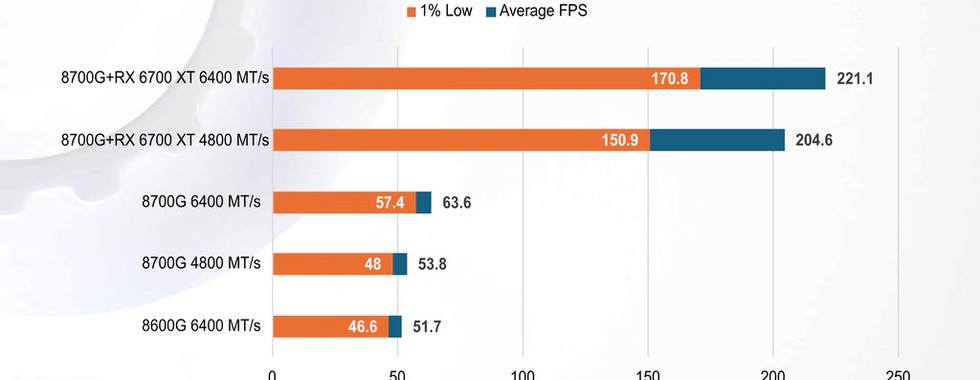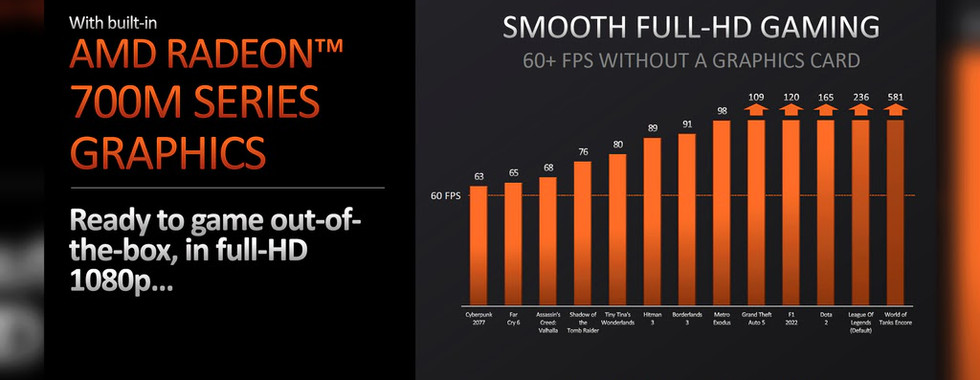During CES we got a sneak preview of AMD’s latest CPUs which they claimed have the fastest graphics in the world and now we can actually share our findings with you. Brace yourself: these CPUs not only live up to the hype but also come at an enticing price point. Let's dive right in.
First, I want to cover what's on the horizon. On January 31st, AMD is set to launch 4 different CPU’s. While three of them will be readily available for the DIY market, the 8300G will exclusively be distributed by system builders such as Dell and HP.
These processors are built on AMD's advanced Zen 4 architecture. Among the four SKUs, the top two boast full-size cores, while the bottom two exhibit a combination of Zen 4 and Zen 4c cores. However, the true standout feature of this release extends beyond sheer processing power – it lies in the seamless integration of cutting-edge Radeon graphics, promising to deliver impressive gaming experience.
Now, let's take a closer look at the two CPUs that we are reviewing, starting with the Ryzen 7 8700G. As the flagship of this release, it boasts an impressive eight cores and 16 threads, making it a great for both gamers and creators. What truly sets this CPU apart is its integrated Radeon 780M graphics, claiming the title of the fastest graphics available in a desktop processor.
Next in line is the Ryzen 5 8600G, equipped with six cores and 12 threads, it's designed for those who need strong performance but at a more accessible price point. With Radeon 760M graphics, it ensures smooth gameplay and efficient multitasking for a wide range of applications.
Another interesting observation with these CPU’s is their memory support. Until now, the latest Zen 4 CPUs performed at their best at 6000 MT/s and depending on your luck could go up to about 6400 MT/s. However, these new chips push past that. In our tests, the memory was clocked at an impressive 6400, and AMD suggests that reaching 8000 is a feasible objective, provided you acquire a suitable memory kit and motherboard, and I can confirm memory speed does make a significant difference when gaming on these chips.
With these latest APUs we also get Ryzen AI through the dedicated accelerator which should be much more efficient on certain AI workloads, but for now there aren’t really many workloads to test this on so the jury is out on this one.
In terms of pricing, the Ryzen 7 8700G, with its 329 USD MSRP, and the Ryzen 5 8600G, priced at 229 USD, represent AMD's gamble on the integrated graphics market. This move appears to signal AMD's vision for a shift in the industry towards more integrated and efficient computing solutions which I think will finally kill off any super low-end discrete graphics cards.
To see how they perform we are going to start with more CPU compute-focused tasks. Please bear in mind that due to this being a new platform, our tests primarily focus on comparing these two chips against each other. However, feel free to let us know if you'd like us to explore this segment further and continue testing different CPUs with integrated graphics.
Now, let's talk numbers and how these CPUs stack up, especially with different RAM speeds and against discrete GPUs. In Vray the Ryzen 7 8700G, equipped with 6400 MT/s memory outperformed the 8600G by approximately 28%, showcasing its superior rendering capability. When compared to the 8700G with 4800 MT/S, the improvement was around 5%, underscoring the impact of higher memory speeds.
Shifting our focus to Cinebench R23, specifically in the multi-core performance category, the 8700G with 6400 MT/S saw a 7% improvement over the same CPU with 4800 MT/S RAM, and a whopping 33% improvement over the 8600G. More cores here is more better. It's worth noting that the single-core scores are equally intriguing, as they match, contributing to the overall system's snappiness and favouring games that demand fast single-core performance.
In the case of Cinebench R24, we observe strikingly similar outcomes, just with more modest numerical variations, but the ranking remains consistent.
In single-threaded 7-Zip task, the Ryzen 7 8700G with 6400 MT/S memory shows superior compressing performance, while decompressing performance is relatively similar across all configurations. This indicates that for single-threaded file compression tasks, the Ryzen 7 8700G, particularly with higher memory speeds, offers the best performance. However, decompression tasks seem to be less impacted by CPU model and memory speed.
When we look at the multi-threaded 7-Zip tasks, the Ryzen 7 8700G with 6400 MT/S memory demonstrates the highest performance in both compressing and decompressing, significantly outperforming the Ryzen 5 8600G and its own 4800 MT/S configuration. This highlights the advantage of the Ryzen 7 8700G's additional cores and threads, as well as the impact of higher memory speeds on multi-threaded performance.
In our gaming benchmarks with "Shadow of the Tomb Raider" at 1080p with the lowest settings, the Ryzen 7 8700G with 6400 MT/S outshines the 4800 MT/S configuration by nearly 20% and exceeds the Ryzen 5 8600G by over 23%.
When we bring the RX 6700 XT into the mix, the performance jumps dramatically. Paired with the 8700G, the setup sees over a 200% increase in performance compared to the integrated graphics alone. With faster 6400 MT/S memory, the improvement is even more pronounced.
This showcases the sheer impact of pairing a potent discrete GPU with high-speed memory, offering substantial gains for gamers. However, the integrated graphics of the 8700G still stand tall, providing a solid option for those prioritizing budget or simplicity in their setup. With over 70 FPS the game is more than playable and there is no need for a separate 350 USD worth GPU.
At Low Quality setting, the 8700G with 6400 MT/S memory performs about 18% better in average FPS than with 4800 MT/S and roughly 23% better than the 8600G. Here we are getting very close to 60 FPS on the higher-end chip and probably limit on what we can do without upscaling.
For "F1 2022" at 1080p Low settings, the integrated GPUs exhibit notable performance differences influenced by RAM speeds. The Ryzen 7, paired with 6400 MT/S memory, experiences a remarkable 21% boost in average FPS compared to its 4800 MT/S setup. This underscores how faster memory can unleash more of the CPU's potential. Additionally, when compared to the Ryzen 5 with 6400 MT/S RAM, the 8700G demonstrates a 14% improvement, emphasizing that having more cores can lead to better performance.
Stepping up to 1080p Medium settings in "F1 2022," we find that increasing the graphical quality still results in more than 60 FPS with the integrated graphics of the 8700G and high-speed RAM. This performance demonstrates its ability to handle more demanding graphical settings. While it's important to note that a discrete GPU outperforms it significantly, it's worth keeping in mind that the GPU alone costs more than this CPU.
In "Starfield" at 1080p Low settings, the 8700G with 6400 MT/S edges out its 4800 MT/S setup and notably surpasses the 8600G, reaffirming the importance of having more cores and faster memory. Although these integrated graphics fall short of the typical playable threshold of at least 60 FPS, achieving nearly 40 FPS is still quite impressive, considering that this is a modern triple-A title.
AMD did place a stronger focus on lighter games, but I think it is important to find limitations here. With basic games like League of Legends and Dota 2 I am sure it will do fine and there is still upscaling and frame generation tech to leverage, but over all its not bad.
With this in mind, let’s have a look how both of these chips do with power and more importantly thermals. We set them to Prime95 with our custom burn in test and as you can see both chips quickly hit 95 degrees. They are equipped with the coolers that come in the package - the 8700G comes with AMD Wraith Spire and 8600G with AMD Wraith Stealth Cooler. To be honest, both of these coolers leave much to be desired. While they might suffice for light gaming sessions in the short term, it's advisable to invest in a more capable cooler for prolonged use.
Both of these chips are rated at 45-65W which as you can see in this graph lets them hit about 90W so get a dual fan single tower cooler or even lower end dual tower or 240mm AIO to ensure you get the most out of them.
This brings us to our conclusion, and I must say that while APUs are not a novel concept, these chips have piqued my interest, and they should capture your attention as well. The fact that AMD can deliver such performance at an attractive price point is phenomenal and I am really looking forward to people testing them with 8000 MT/S memory too.
Granted, at the moment, that level of memory might cost more than the chip itself, but it's an investment that can serve you well for a considerable time. Personally, I believe these CPUs will serve as an excellent starting point for individuals building their first PC or those on a tight budget, providing both gaming capability and productivity potential, with a promising upgrade path for the future.
What are your thoughts? Is this something you'd consider purchasing, or would you give it a pass? Share your opinions with us in the comments below.
__________________________________________
Affiliate disclosure: as an Amazon Associate, we may earn commissions from qualifying purchases from Amazon.




























































Commenti